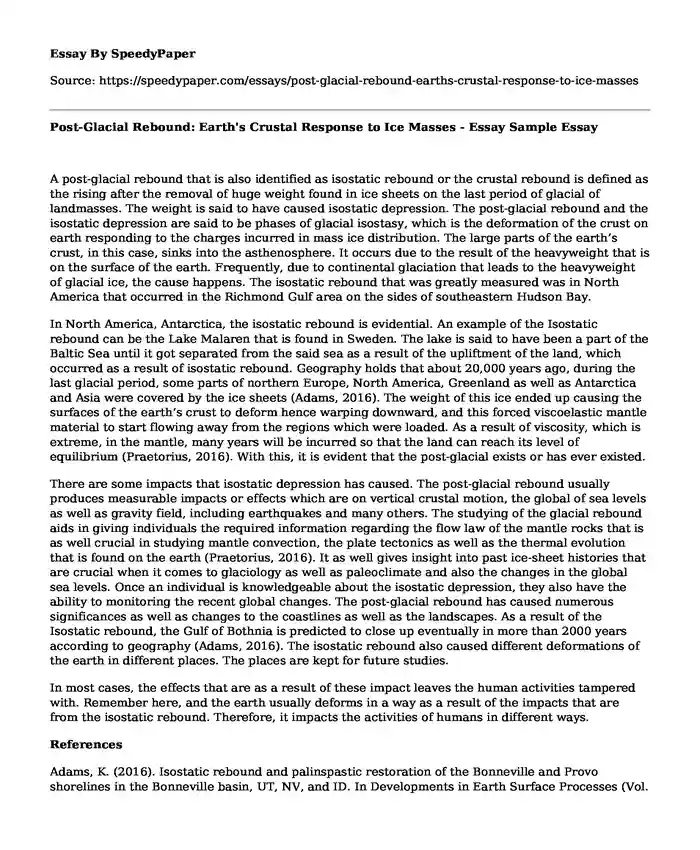
| Type of paper: | Essay |
| Categories: | Environment Ecology Geology Nature World |
| Pages: | 3 |
| Wordcount: | 646 words |
A post-glacial rebound that is also identified as isostatic rebound or the crustal rebound is defined as the rising after the removal of huge weight found in ice sheets on the last period of glacial of landmasses. The weight is said to have caused isostatic depression. The post-glacial rebound and the isostatic depression are said to be phases of glacial isostasy, which is the deformation of the crust on earth responding to the charges incurred in mass ice distribution. The large parts of the earth’s crust, in this case, sinks into the asthenosphere. It occurs due to the result of the heavyweight that is on the surface of the earth. Frequently, due to continental glaciation that leads to the heavyweight of glacial ice, the cause happens. The isostatic rebound that was greatly measured was in North America that occurred in the Richmond Gulf area on the sides of southeastern Hudson Bay.
In North America, Antarctica, the isostatic rebound is evidential. An example of the Isostatic rebound can be the Lake Malaren that is found in Sweden. The lake is said to have been a part of the Baltic Sea until it got separated from the said sea as a result of the upliftment of the land, which occurred as a result of isostatic rebound. Geography holds that about 20,000 years ago, during the last glacial period, some parts of northern Europe, North America, Greenland as well as Antarctica and Asia were covered by the ice sheets (Adams, 2016). The weight of this ice ended up causing the surfaces of the earth’s crust to deform hence warping downward, and this forced viscoelastic mantle material to start flowing away from the regions which were loaded. As a result of viscosity, which is extreme, in the mantle, many years will be incurred so that the land can reach its level of equilibrium (Praetorius, 2016). With this, it is evident that the post-glacial exists or has ever existed.
There are some impacts that isostatic depression has caused. The post-glacial rebound usually produces measurable impacts or effects which are on vertical crustal motion, the global of sea levels as well as gravity field, including earthquakes and many others. The studying of the glacial rebound aids in giving individuals the required information regarding the flow law of the mantle rocks that is as well crucial in studying mantle convection, the plate tectonics as well as the thermal evolution that is found on the earth (Praetorius, 2016). It as well gives insight into past ice-sheet histories that are crucial when it comes to glaciology as well as paleoclimate and also the changes in the global sea levels. Once an individual is knowledgeable about the isostatic depression, they also have the ability to monitoring the recent global changes. The post-glacial rebound has caused numerous significances as well as changes to the coastlines as well as the landscapes. As a result of the Isostatic rebound, the Gulf of Bothnia is predicted to close up eventually in more than 2000 years according to geography (Adams, 2016). The isostatic rebound also caused different deformations of the earth in different places. The places are kept for future studies.
In most cases, the effects that are as a result of these impact leaves the human activities tampered with. Remember here, and the earth usually deforms in a way as a result of the impacts that are from the isostatic rebound. Therefore, it impacts the activities of humans in different ways.
References
Adams, K. (2016). Isostatic rebound and palinspastic restoration of the Bonneville and Provo shorelines in the Bonneville basin, UT, NV, and ID. In Developments in Earth Surface Processes (Vol. 20, pp. 145-164). Elsevier. https://www.sciencedirect.com/science/article/pii/B9780444635907000081
Praetorius, S. (2016). Interaction between climate, volcanism, and isostatic rebound in Southeast Alaska during the last deglaciation. Earth and Planetary Science Letters, 452, 79-89. https://www.sciencedirect.com/science/article/pii/S0012821X16303892
Cite this page
Post-Glacial Rebound: Earth's Crustal Response to Ice Masses - Essay Sample. (2023, Oct 15). Retrieved from https://speedypaper.com/essays/post-glacial-rebound-earths-crustal-response-to-ice-masses
Request Removal
If you are the original author of this essay and no longer wish to have it published on the SpeedyPaper website, please click below to request its removal:
- Free Essay Example: Cloud Computing
- Essay Example on Gravitational Waves
- Free Essay on Pestle and Cage Analysis of Brazil
- Paper Example on Data Ethics Issues in Big Data Intelligence for Banks
- Essay Example - Gaucher Disease
- "The Way We Think About Biological Sex Is Wrong" by Emily Quinn - Essay Sample
- Free Essay Example: History of Genetics
Popular categories




